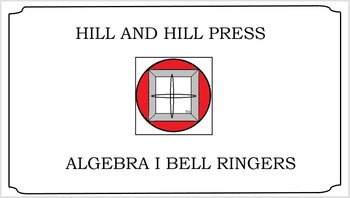Solve Systems of Equations by Elimination (5 Algebra I Bell Ringers]
Hill and Hill Press
16 Followers
Grade Levels
7th - 9th
Subjects
Resource Type
Standards
CCSSW.7.1
CCSSMP1
Formats Included
- PPTX
Pages
14 pages
Hill and Hill Press
16 Followers
Description
Incorporate Reading and Writing in Mathematics with this series of PowerPoint presentations! For classroom instruction, this product is best when used with a LCD Projector. For individual or small group instruction, any delivery method will suffice. This file provides bell ringer activities for the above named skill for 5 days of instruction. It is highly recommended that you begin this as an Individual activity to develop critical thinking and reasoning in your students. Offer assistance only after they have written or drawn what they could on page 1, by single clicking the PowerPoint step by step as you prompt volunteers to state each correct step. When page 1 is completed, ask students to flip over to page 2 and describe the step by step process followed by the class, but this time in written form. Yes, they will grumble at first but if successful, you will see an improvement in Math, Reading and Writing Scores! When your principal visits your classroom during this activity you will get the nod of approval! I did.
Student Forms - pages 1 and 2 are included in this PowerPoint.
Student Forms - pages 1 and 2 are included in this PowerPoint.
Total Pages
14 pages
Answer Key
Included
Teaching Duration
1 Week
Last updated Aug 10th, 2016
Report this resource to TPT
Reported resources will be reviewed by our team. Report this resource to let us know if this resource violates TPT’s content guidelines.
Standards
to see state-specific standards (only available in the US).
CCSSW.7.1
Write arguments to support claims with clear reasons and relevant evidence.
CCSSMP1
Make sense of problems and persevere in solving them. Mathematically proficient students start by explaining to themselves the meaning of a problem and looking for entry points to its solution. They analyze givens, constraints, relationships, and goals. They make conjectures about the form and meaning of the solution and plan a solution pathway rather than simply jumping into a solution attempt. They consider analogous problems, and try special cases and simpler forms of the original problem in order to gain insight into its solution. They monitor and evaluate their progress and change course if necessary. Older students might, depending on the context of the problem, transform algebraic expressions or change the viewing window on their graphing calculator to get the information they need. Mathematically proficient students can explain correspondences between equations, verbal descriptions, tables, and graphs or draw diagrams of important features and relationships, graph data, and search for regularity or trends. Younger students might rely on using concrete objects or pictures to help conceptualize and solve a problem. Mathematically proficient students check their answers to problems using a different method, and they continually ask themselves, "Does this make sense?" They can understand the approaches of others to solving complex problems and identify correspondences between different approaches.


